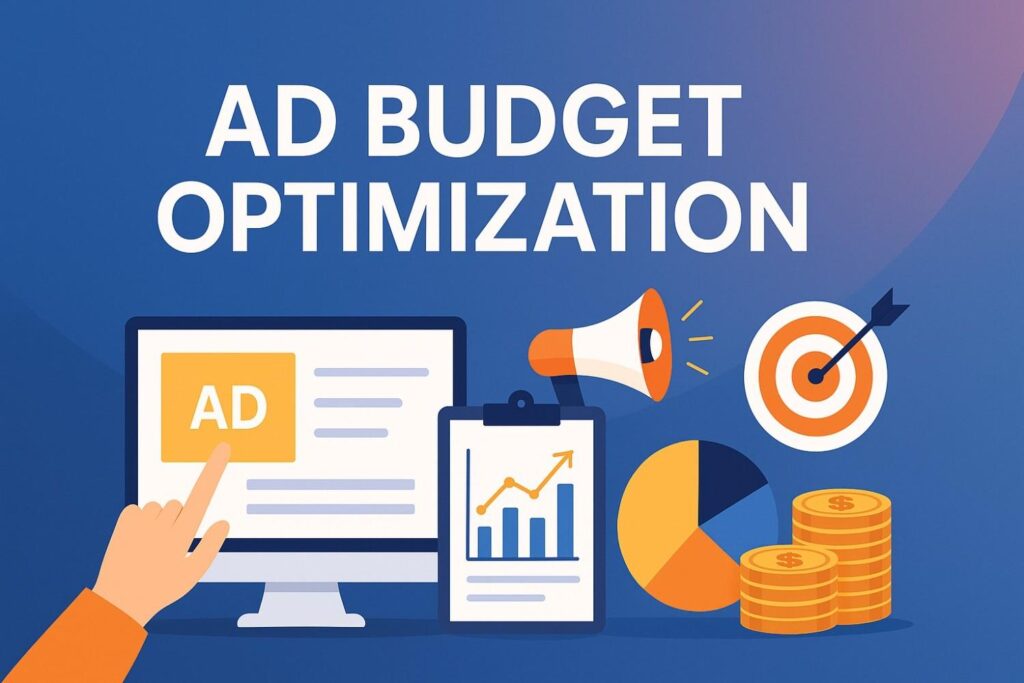Table of Contents
Let’s face it—spending money on ads is easy. Getting results? Not so much. You launch a campaign, set a budget, and hope it brings in leads or sales. But if you’re not keeping an eye on how your money’s being spent, it’s like filling a bucket with holes.
That’s where ad budget optimization comes in. It’s not just about cutting costs—it’s about making every dollar work harder. And in 2025, with ad costs rising and attention spans shrinking, smart spending is non-negotiable.
If your ads are draining your wallet without delivering results, this blog is for you.
So, What Exactly Is Ad Budget Optimization?
In simple terms, ad budget optimization is about making sure every dollar (or rupee or euro) you spend on advertising actually works for you. It’s the process of adjusting your budget across platforms, campaigns, audiences, and timings to get the best return on your investment.
Think of it like tuning an engine. You don’t need more fuel—you need it to run efficiently. Same goes for your ad spend.
Why Ad Budget Optimization Is a Game-Changer
Let’s break it down.
- Ad platforms are crowded. You’re not just competing with your direct competitors—you’re up against every other brand out there.
- Costs are rising. Whether it’s Google Ads or Meta, clicks and impressions are getting pricier.
- Consumer behavior is changing. People want value, authenticity, and relevance—fast.
Without a strategy in place, it’s easy to throw money at underperforming ads while ignoring the ones that actually convert.
That’s why ad budget optimization has become a must, not a maybe. It’s the secret sauce behind every high-performing digital campaign.
1. Start With an Audit—Not a Guess
Before you make any changes, stop and take a look under the hood.
- Where is your money going right now?
- Which campaigns are generating results?
- Which ones are just burning cash?
Use tools like Google Ads Manager or Meta Business Suite to check your cost-per-click (CPC), cost-per-acquisition (CPA), and conversion rates. This isn’t just data—it’s your roadmap for smart ad budget optimization.
If something isn’t working, don’t keep feeding it money. Cut it, tweak it, or replace it.
2. Don’t Treat Every Audience the Same
If you’re running one campaign for everyone, you’re already wasting budget.
Break your audience into groups:
- Cold audience (people who’ve never heard of you)
- Warm audience (people who’ve checked out your site or interacted with your posts but haven’t converted yet)
- Hot audience (cart abandoners, past buyers, email subscribers)
Each of these needs different messaging—and different budget priorities.
By tailoring your strategy, you’re practicing smarter ad budget optimization. You’re not throwing spaghetti at the wall—you’re giving each group exactly what they need to take the next step.
3. Get Crystal Clear on Your Goals
This is a big one. What are you actually trying to do with your ads?
- Build awareness?
- Collect leads?
- Drive sales?
Each goal needs a different type of campaign—and a different way to measure success.
When your goals are clear, your budget works with purpose—not guesswork. And that’s the foundation of great ad budget optimization.
4. Let Data Be Your Guide (Not Your Ego)
We’ve all been there—launching an ad we love because it looks great or sounds clever. But then it flops.
Here’s the truth: the best-performing ads aren’t always the prettiest—they’re the ones that connect.
Check your metrics regularly:
- Click-through rate (CTR)
- Bounce rate
- Time on site
- Conversion rate
If the numbers say an ad’s working, scale it. If they say it’s failing, kill it—no matter how cool it looks.
That’s real-world ad budget optimization. No ego, just results.
5. Be Smart About When and Where You Show Ads
Ever run ads in the middle of the night when your audience is asleep? Yeah, that’s money gone.
Run your ads when your audience is most active—dayparting helps you hit those peak hours. Test different time blocks and watch how performance shifts.
And don’t forget about location targeting. If 80% of your sales come from five cities, why are you spending money in fifty?
These simple tweaks can seriously improve your ad budget optimization—without spending a penny more.
6. Spread the Budget, But Don’t Spread It Thin
It’s tempting to run ads everywhere—Google, Facebook, Instagram, TikTok, LinkedIn.
But here’s the thing: not every platform is right for your brand or audience.
Start small. Test a couple platforms, then double down on what works. This focused strategy helps you avoid the “spray and pray” approach and gives your ad budget optimization real power.
7. Use Automation—But Don’t Set and Forget
Tools like Google’s Performance Max or Meta’s Advantage+ can automate bidding, targeting, and placements. Handy, right?
Yes—but they’re not foolproof. You still need to guide them.
Check your results often. Adjust creative. Watch spend trends. Automation can support your ad budget optimization efforts, but it doesn’t replace your brain.
Think of it like autopilot—it helps, but you’re still the pilot.
Bonus: Retargeting = Low-Hanging ROI
Retargeting is one of the easiest ways to stretch your ad budget.
These are people who already interacted with your site or ads. They know you. They’re close to buying.
A well-timed retargeting ad—maybe with a discount or a reminder—can drive conversions fast and cheap. It’s a go-to tactic in any solid ad budget optimization plan.
Final Thoughts: Spend Smarter, Not Harder
There’s a common myth that to win with ads, you need a big budget.
Wrong.
What you need is a smart budget—one that’s constantly learning, adapting, and improving. One that aligns with your goals, speaks to your audience, and follows the data.
That’s the magic of ad budget optimization. It’s not just about spending less—it’s about making every penny count.
So before you boost another post or launch a new campaign, ask yourself:
Am I spending wisely—or just spending?

